ARANKELE: An Incredible Ancient Forest Hermitage in an Amazing Natural Setting
Posted on July 11th, 2017
Dr. Daya Hewapathirane
July 10, 2017
Arankele, can be reached via the Kurunegala-Dambulla main road and turning off to the Ibbagamuwa-Moragolla road. Arankele is one of the oldest and premier forest hermitages of Sri Lanka, highly reputed since historic times, as an austere abode of an exclusive group of reclusive Bhikkhus, who were deeply devoted to meditation and spiritual advancement. Inevitably, they were attracted to this enchanting, forested, remote hill-slope site because of its seclusion and serene atmosphere. The Arankale site is within in the intermediate climate zone of the country, with a thick natural forest cover, an ideal environment for meditating monks. The hillslopes of Arankele are marked by a cluster of natural rock caves which have been used by Buddhist monks in the past, for shelter and meditation. The forested hillside is still in use by meditating Buddhist Bhikkhus. It is reported that in ancient times, Arankele accommodated about 12,000 meditating monks. Arankele means ‘the forest of Arahaths’. Arahath” in general, may be defined as a perfected person”, a person who has attained enlightenment and will attain nibbana (nirvana) upon the persons death.
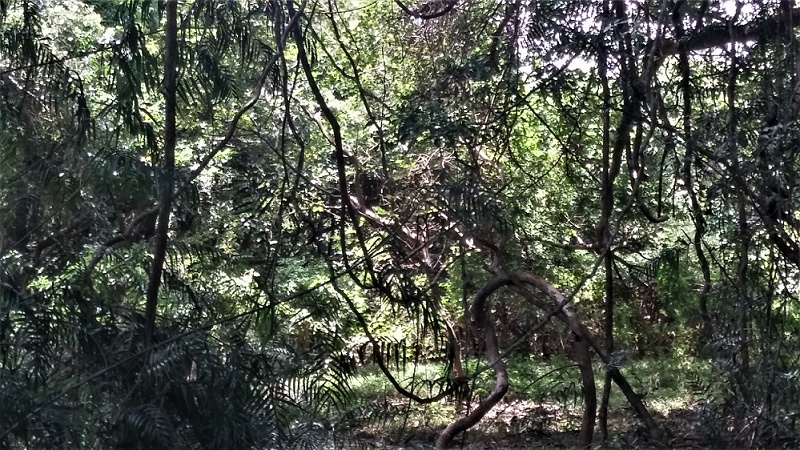
Arankele Forest Hermitage was established more than 2000 years ago, around the 2nd century CE, exclusively for Bhikkhus engaged in deep meditation. According to the Mahavamsa, Arahath Maliyadeva who lived in Sri Lanka during the 2nd century BCE, made Arankele his abode, and his meditation chamber still evident in Arankele, dates back to the 2nd century BCE. He is regarded as the last known Arahath of the country. The original Arankele Hermitage was expanded and improved at various times in the past, especially in the late 3rd and the 4th centuries during the reigns of the kings Mahasena (277-304 CE, his son Jethatissa (332-341 CE), and Buddhagosha (341-370 CE). King Buddadasa, who was a specialist in ayurveda, instructed the planting of medicinal plants around the monastery. The forest land of Arankale forest land is surrounded by Dolukanda, Dunkanda and Madukanda mountains which from ancient times, consisted of a diversity of medicinal trees and plants popularly used in ayurveda. There is a rich diversity of flora and fauna in Arankele. The densely wooded terrain of Arankele, is crowded with huge hardwood trees, interspersed by some clearings where most of the archeological remains are present. In addition to the diversity of trees, creepers, and other flora, the Arankele forest is the abode of several types of wildlife, monkeys and birds being the popularly seen ones. There are numerous species of reptiles, amphibians, butterflies and other types of insects in Arankale.
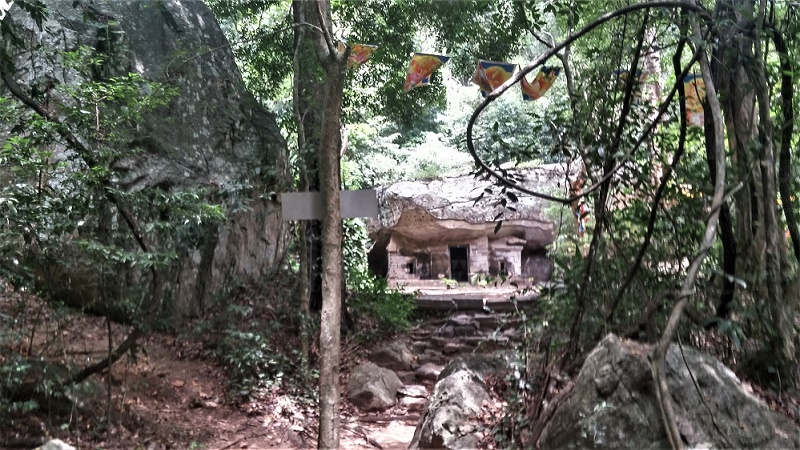
Today, Arankele is a renowned archaeological site with unique and remarkable ruins of an extensive forest hermitage complex of ancient times. Ancient Rock inscriptions have revealed the existence of long pathways, meditation halls, stone-faced double platform structures and ambulatories for the austere Buddhist monks living in the Arankele Monastery. There are well laid out ancient pathways through the canopy of giant forest trees and dramatic creepers. The Cankamanaghara which is a common feature in the Arankele site, are sheltered promenades or walkways extending through the forest in peace and tranquility of the enchanting surroundings. There are several well-designed paved long walkways or promenades within the site. Most are primarily meant for walking meditation. Some of them believed to have been roofed. There are long winding pathways that cut across the dense forest and leading to rock caves with drip-ledges which were used in the past for mediation. Arankele is famous for the 2,000 feet longest meditation pathway in Sri Lanka.
Pethmaga (Pathway) is one of longest pathways, which leads from the caves to each section of the monastery. It connects each section and makes it easier to achieve from one section to another. This is a sand paved pathway and the lines of two edges are paved stones. This pathway consists of Chankamanapaya. Chankamandapaya was employed by the Bhikkhus to rest when they were returning from meditation grounds to the other section of monastery. The plan from of this Chankamandapaya is circular and it was built with per-caste stones. This Chankamandapaya is one of the key features of Arankele forest monastery. Generally, only Padanagara type of monasteries consists of Chankamandapaya.
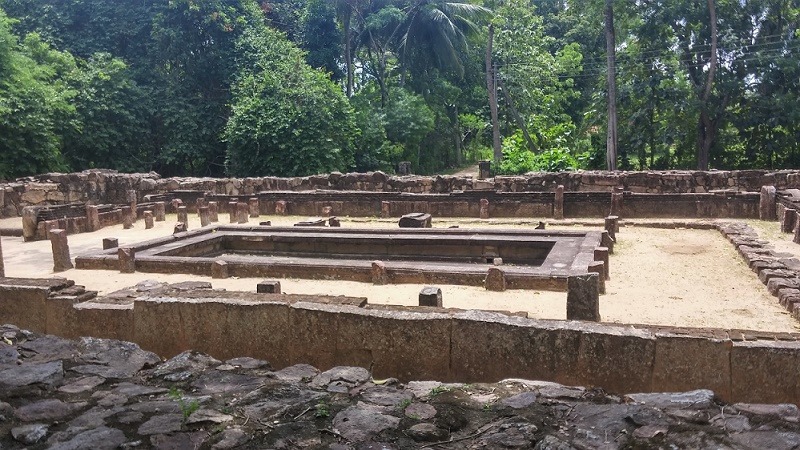
At the end of one of the long pathways, beside a small clearing, is a small rock cave which had been fashioned into a three-roomed little abode. By the entrance door were two low steps flanked by a quaint miniature balustrade and stone guard stones but devoid of sculpture or other decorations. From the entrance hall two doors opened into two rooms on either side Each room contained a window opening to the front and a stone slab bed. This is where Arahat Maliyadeva lived. This was his holy abode surrounded by the forest, wild animals, birds, reptiles and insects.
The ruins of a prominent building at the entrance of the Arankele site from the northeast, is known as a Jantaghara or a hot water bathing houses with the dimensions of 100feet in length and 60feet in width. These basically are meant for the aged and sick Bhikkhus. In the Jantaghara, places are set aside for hot baths, saunas and medicinal baths. In this building are the hearths used for boiling water and grinding stones used for preparing herbal medicines and herbal medicinal pastes. Sanitary facilities comprising washrooms, toilets and urinals are near the building. The ruins that have been unearthed so far testifies to the former existence of a large Ayurvedic hospital within the Arankele monastery.
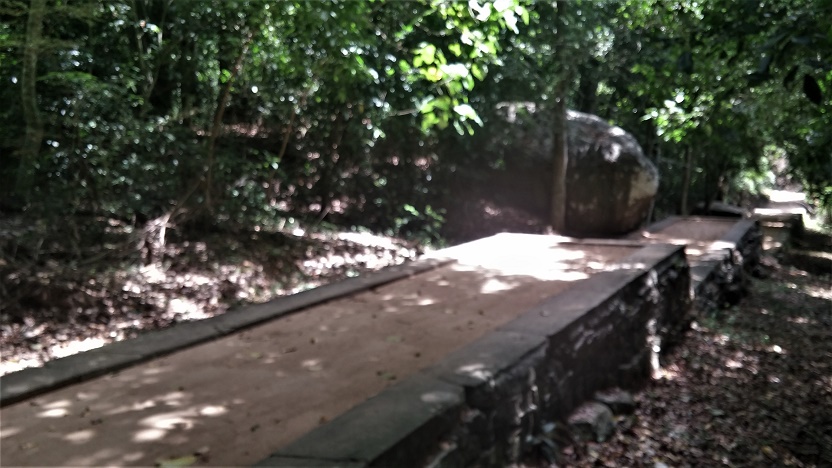
The highlight of this monastery is the double platform buildings which are raised platforms formed by retaining walls of massive stone. These stones are found in pairs and are linked together by a stone bridge. These platforms were used for meditation, ceremonies and teaching, but its definite purpose is yet to be identified. Access to the building is from either side of the stone bridge by two short flights of steps in the centre and between the two platforms. Another special characteristic of these buildings is the surrounding water troughs which are said to have kept the interior of the building cool.
Sammukalena is a unique building in Arankele. This was a waiting room for visitors in monasteries. Outsiders were not allowed to visit most part of the monastery as it disturbed the activities of Bhikkhus. Sammukalenes were constructed to keep visitors waiting till someone comes and accompany them. The massive stone pillars of the building had been supported to bear the-roof.
There are also ruins of dining or alms-giving halls and bathing ponds. There were three bathing ponds for meditating monks in Arankele, of which one has been restored completely. It is a very large ancient pond with water lilies, 138 feet long and 107 feet wide, made of solid blocks of rock. There is also a well- designed pond located within the nearby forest, meant exclusively for the supply of drinking water. This is a perennial pond that does not dry-up even during acute drought conditions. A special characteristic of some Arankele buildings is that they were surrounded by water troughs believed to keep the interior of the building cool. Evidence of such buildings are also found at Ritigala, and Mihintale.
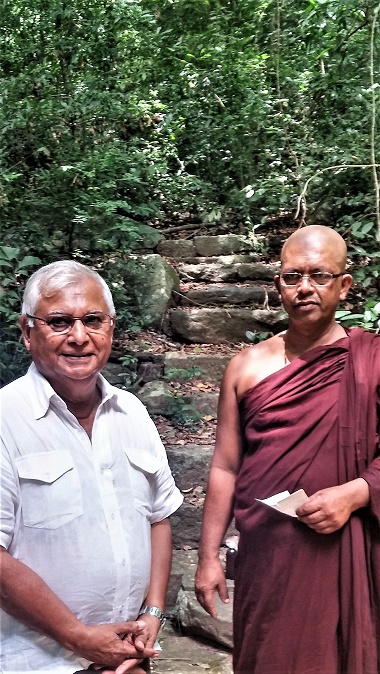
Granite is the popularly used structural material in Arankele. Pathways are defined by using well dressed curb stones. Edges of the pathways, steps, retain walls and building in the monastery are made of cut granite stones and dressed granite slabs and remaining of these stone pillars can be still seen on the premises of Arankele. Durability of the material a main reason for using in the monastic places such as Arankele which were dedicated for higher purposes. Also, granite was the best structural material in that era. Almost all the buildings were done with prefabricated stones and stone pillars. They were sharply cut and well smoothened. Fine sand was spread on pathways and court yards in the monastery.
In line with the typical simplicity of the meditating monks who used these buildings, and their austere religious practices the buildings of Arankele has been built with no pretensions to decorations. All this was in keeping with the severe simplicity and austere religious practices which ruled the lives of these monks, and with their aim to revive the way of life led by the Buddha and his disciples after his Enlightenment. Also significant was the absence of stupas, shrines identified with the Bo – tree, or images.
Prof. Senerath Paranavithana, the renowned archaeologist, once explained that hermitages such as Arankele are rare worldwide. A comment of one foreign visitor to Arankela was Walking around the wooded shade helps to calm down one’s stressed nerves. Gigantic trees, their barks entwined with three-inch thick vines, add to the feeling of being in the thick of the forest, while the whisper of leaves rustling in the breeze adds to the bird song.”
Arankale is a remarkable historical site with archaeological remains that are vividly reflective of the highly developed, remarkable architectural skills of the ancient Sinhala builders. It is a biologists’ paradise, and a treasure-house of medicinal plants, and an exciting place for bird and butterfly watchers and wildlife enthusiasts. Its invigorating natural environmental setting, its inspirational archeological remains, and above all the peace and tranquility that one feels in its midst, make Arankele an ideal place for those who are spiritually inclined, and are in search of inner peace and inner transformation.
Dr. Daya Hewapathirane July 10, 2017
July 12th, 2017 at 5:20 am
It won’t last very long. Sri Lanka Multiplying Community aka mussies will start a housing project. Of course it will be
from donations from an arab country to resettle displaced people meaning mussies only (afganisthan, pakesthan
etc. of course qualify). Mussies multiply like xxxx and outnumber the natives wherever they go. That’s how old
Buddhist iran, afganisthan, pakesthan, bangladesh, maldives, malaysia, indonesia became mussies within a few
hundred years of their arrival in those countries.
Now Sri Lanka is under the mussie cosh with the help of traitor
Sinhala deshapaluwan who turn a blind eye to mussie onslaught. These mussies should learn Charles Darwin’s
Theory of Evolution. It really explains how these two legged creatures came to being (no god, no messenger). It also explains why so many
mussies die all around the world by his Theory of Natural Selection. Nature (not god) has mechanisms to control
numbers. If there are too many, then there will be wars/famines/disasters etc. Fastest breeding religion should
study these theories and follow a true religion like Buddhism, a lot of problems in the world going to be solved.